Related Research Articles

Cloning is the process of producing individual organisms with identical or virtually identical DNA, either by natural or artificial means. In nature, some organisms produce clones through asexual reproduction. In the field of biotechnology, cloning is the process of creating cloned organisms (copies) of cells and of DNA fragments.
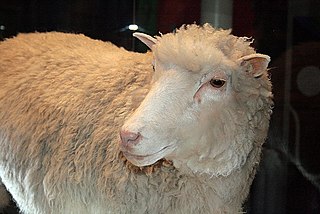
Dolly was a female Finnish Dorset sheep and the first mammal cloned from an adult somatic cell. She was cloned by associates of the Roslin Institute in Scotland, using the process of nuclear transfer from a cell taken from a mammary gland. Her cloning proved that a cloned organism could be produced from a mature cell from a specific body part. Contrary to popular belief, she was not the first animal to be cloned.
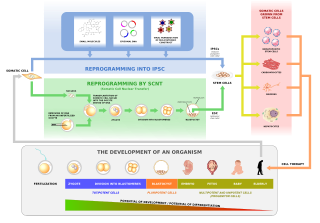
Human cloning is the creation of a genetically identical copy of a human. The term is generally used to refer to artificial human cloning, which is the reproduction of human cells and tissue. It does not refer to the natural conception and delivery of identical twins. The possibility of human cloning has raised controversies. These ethical concerns have prompted several nations to pass laws regarding human cloning.

In genetics and developmental biology, somatic cell nuclear transfer (SCNT) is a laboratory strategy for creating a viable embryo from a body cell and an egg cell. The technique consists of taking an enucleated oocyte and implanting a donor nucleus from a somatic (body) cell. It is used in both therapeutic and reproductive cloning. In 1996, Dolly the sheep became famous for being the first successful case of the reproductive cloning of a mammal. In January 2018, a team of scientists in Shanghai announced the successful cloning of two female crab-eating macaques from foetal nuclei.

Cashmere wool, usually simply known as cashmere, is a fiber obtained from cashmere goats, pashmina goats, and some other breeds of goat. It has been used to make yarn, textiles and clothing for hundreds of years. Cashmere is closely associated with the Kashmir shawl, the word "cashmere" deriving from an anglicisation of Kashmir, when the Kashmir shawl reached Europe in the 19th century. Both the soft undercoat and the guard hairs may be used; the softer hair is reserved for textiles, while the coarse guard hair is used for brushes and other non-apparel purposes.

Sir John Bertrand Gurdon is a British developmental biologist. He is best known for his pioneering research in nuclear transplantation and cloning. He was awarded the Lasker Award in 2009. In 2012, he and Shinya Yamanaka were awarded the Nobel Prize for Physiology or Medicine for the discovery that mature cells can be converted to stem cells.
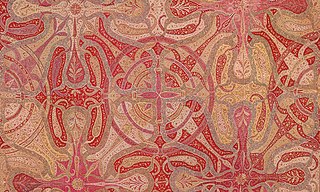
Pashmina refers to a fine variant of spun cashmere, the animal-hair fibre forming the downy undercoat of the Changthangi goat. The word pashm means "wool" in Persian, but in Kashmir, pashm referred to the raw unspun wool of domesticated Changthangi goats. In common parlance today, pashmina may refer either to the material or to the variant of the Kashmir shawl that is made from it. Both generic cashmere and pashmina come from the same goat, but generic cashmere ranges from 12 to 21 microns in diameter, whereas pashmina refers only to those fibres that range from 12 to 16 microns.
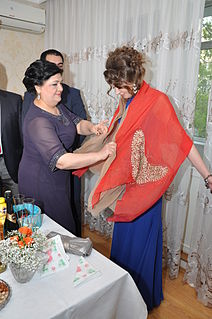
A shawl is an Indian simple item of clothing, loosely worn over the shoulders, upper body and arms, and sometimes also over the head. It is usually a rectangular or square piece of cloth, which is often folded to make a triangle, but can also be triangular in shape. Other shapes include oblong shawls.

Bangladesh Agricultural University, abbreviated as BAU, was established as the only university of its kind in Bangladesh in 1961. The scheme for BAU was finalised on 8 June 1961 and its ordinance was promulgated on 18 August 1961. It started functioning with the College of Veterinary Science and Animal Husbandry at Mymensingh as its nucleus. The university has six faculties and 43 departments covering all aspects of agricultural education and research.

Shahtoosh is a fine type of wool made from the hair of the Tibetan antelope. It is also a metonym for a type of Kashmir shawl traditionally made of shahtoosh wool. The Shahtoosh shawl is now a banned item with possession and sale being illegal in most countries for the Chiru is an endangered species under CITES. However, the weaving of Shahtoosh shawls continues in secret in Kashmir due to high demand by western buyers. The estimated market value of one Shahtoosh shawl in the western market is around $5,000–$20,000. Shahtoosh is the world's finest wool having the lowest micron count, followed by vicuña.
Commercial animal cloning is the cloning of animals for commercial purposes, currently, including livestock, competition camels and horses, pets, medical uses, endangered and extinct animals, as first demonstrated in 1996 for Dolly the sheep.
The Texas A&M College of Veterinary Medicine & Biomedical Sciences is a college of Texas A&M University in College Station, Texas. The college was founded in 1916 and is one of only 31 colleges of veterinary medicine in the United States and Canada. It is consistently ranked as one of the top 5 vet schools in the country, according to U.S. News. The college offers an undergraduate program in Biomedical Sciences, a professional Doctor of Veterinary Medicine program, and numerous graduate programs relating to veterinary medicine and epidemiology.

A cashmere goat is a type of goat that produces cashmere wool, the goat's fine, soft, downy, winter undercoat, in commercial quality and quantity. This undercoat grows as the day length shortens and is associated with an outer coat of coarse hair, which is present all the year and is called guard hair. Most common goat breeds, including dairy goats, grow this two-coated fleece.

Motilal Madan is an Indian biotechnology researcher, veterinarian, academic and administrator. In a career spanning over 35 years, Madan published 432 research articles and policy papers in international and national reference journals—including 226 original research papers—and pioneered research in reproductive endocrinology, embryo biotechnology, In vitro fertilisation, and cloning.

Sher-e-Kashmir University of Agricultural Sciences and Technology of Kashmir is an agricultural university located in Shalimar, Srinagar, Jammu and Kashmir, India. With its main campus and Faculty of Horticulture in Shalimar, Srinagar, the University has multiple campuses, colleges, research and extension centers across the Kashmir Valley and Ladakh Union Territory. The Faculty of Agriculture (FoA) is located in Wadura, Baramulla and the Faculty of Veterinary Sciences and Animal Husbandry campus is located in Shuhama, Alusteng, Ganderbal.
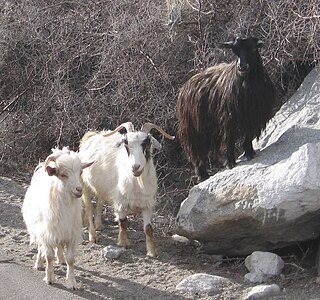
The Changthangi or Changpa is a breed of cashmere goat native to the high plateaus of Ladakh in northern India. It is closely associated with the nomadic Changpa people of the Changthang plateau. It may also be known as the Ladakh Pashmina or Kashmiri.

The Kashmir shawl, the predecessor of the contemporary cashmere shawl, is a type of shawl identified by its distinctive Kashmiri weave, and for being made of fine shahtoosh or pashmina wool. Contemporary variants include the pashmina and shahtoosh shawls. In the late 20th century, they evolved to middle-class popularity through generic cashmere products, and raffal, shawls woven in the Kashmiri style, but using thicker Merino wool. Originally designed as a covering for men in India, it has evolved in the popular cultures of India, Europe, and the United States as indicators of nobility and rank, heirlooms giving on a girl's coming-of-age and marriage, and subsequently, as artistic elements in interior design.

Goat farming involves the raising and breeding of domestic goats as a branch of animal husbandry. People farm goats principally for their meat, milk, fibre and skins.

Morné de la Rey is a South African veterinary surgeon and embryo transfer specialist. In 2003, he was one of a team of scientists and veterinarians from his company Embryo Plus and the Danish Agriculture Institute to clone a cow, the first animal to be cloned in Africa. In 2016, he was one of a team to use in vitro fertilisation successfully for the first time in the Cape buffalo.
References
- 1 2 3 4 "Celebrating world veterinary day-2012 with "NOORI"". greaterkashmir.com. Retrieved 12 December 2012.
- 1 2 3 "Kashmir scientists clone rare cashmere goat". foxnews.com. Retrieved 12 December 2012.
- ↑ "Faculty details". skuastkashmir. Retrieved 12 December 2012.
- ↑ "SKUAST- Kashmir produced world's first cloned Pashmina kid". scoopnews.in. Retrieved 12 December 2012.
- ↑ Franck, Robert R. (October 2001). Silk, Mohair, Cashmere and Other Luxury Fibres. Woodhead Publishing. p. 142. ISBN 1-85573-540-7 . Retrieved 12 December 2012.
- ↑ Morse, Linda; Lidia Karabinech; Lina Perl; Colby Brin (October 2005). Luxury Knitting: The Ultimate Guide to Exquisite Yarns. Sterling Publishing. p. 12. ISBN 1-931543-86-0 . Retrieved 12 December 2012.